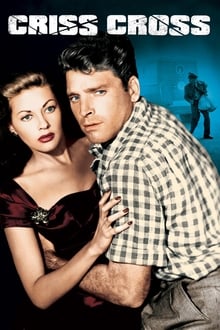
I should have been a better friend. I shoulda stopped you.
Criss Cross is directed by Robert Siodmak and adapted by Daniel Fuchs from Don Tracy's novel. It stars Burt Lancaster, Yvonne de Carlo, Dan Duryea and Stephen McNally. Music is scored by Miklós Rózsa and cinematography is by Franz Planer.
Steve Thompson (Lancaster) and old flame Anna (de Carlo) begin to rekindle their love, much to the dismay of those closest to Steve. She's now unhappily married to mobster Slim Dundee (Duryea), they plan to run away together but Slim is apparently getting wise to their affair. When the two are caught together by Slim, Steve quickly concocts a story that they were plotting an armoured-truck robbery that he wants Dundee to be involved in. Slim notes it's near impossible, but with Steve working for the armoured-truck company it opens the way for inside man possibilities. It deviates suspicion on the lovers, but this is only the start of their problems, for nothing is as it seems.
Criss Cross has come to be a favourite of many a film noir purist, a picture often held forward as one of the shining lights of the 1940's noir universe. But it so easily could have been so different given that the film's original producer, Mark Hellinger, suddenly died of a heart attack. The film under Hellinger's guidance was to be based around a racetrack heist, but with Hellinger's passing the project dropped into limbo and was sold off to Universal along with Lancaster and Siodmak as part of the deal. Although Lancaster was unhappy with the rewritten plot, his relationship with Siodmak had already been cemented three years earlier when they made The Killers, another of film noir's greatest triumphs. For Criss Cross, Siodmak, Fuchs and producer Michael Kraike took Tracy's novel and combined it with elements of The Killers (an Ernest Hemmingway short story). Ava Gardner wasn't on hand to reprise her Killers femme fatale performance, while Shelley Winters was considered but not offered the role that eventually went to de Carlo, who had worked with Lancaster previously on tough as nails prison movie, Brute Force (1947). Rounding out the link between the three protagonists comes with Duryea, he and de Carlo had made Black Bart & River Lady in 1948.
Alls well that ends well, figuratively speaking, because Criss Cross is a superb movie, one that begs to be re-watched whenever possible. All the classic traits of film noir are evident, both technically and narratively. The film begins with a portentous swirl of music from Rózsa, which in turn leads us into a dramatic aerial view of night time Los Angeles. From there we descend towards a parking lot and become witness to an illicit romance between Steve & Anna. At the film's finale we again will be the only witness' to their coupling, only this time it has a kicker, out shot being that Criss Cross is bookended by sheer brilliance. Obsession, betrayal and inescapable fate pervade the narrative from the moment we the audience are clued in to the history of Steve, Anna and Slim. As the tale unfolds in flashback there is a constant sense of feverish doom lingering in the air, aided considerably by Planer's evocative lighting set-ups and Siodmak's wonderful gliding camera and clinical framing compositions of the characters. Even the perky action high point of the robbery comes laced with smoggy gloom, the chaotic sequence only serving as a precursor to the present, where a hospital and a mirror shift us tonally back to the world of unease. And then the finale, one of the most bleakest, and therefore essential, ending in film noir history.
Cast are excellent, Lancaster, all square jawed and square shouldered, plays obsessed loser better than most, thanks in no small part to Siodmak's direction of him. Duryea does what he does best, playing a villain with oily verve and smirky menace, while de Carlo looks great and offers up a nice blend of sweet and rough, a different kind of femme fatale, the actress earning her acting stripes during "that" finale. In the main support slot, McNally impacts well with what he's given to do, and there's good value in the criminal ranks where Alan Napier lurks as the mastermind behind the robbery. Look out, too, for Tony Curtis, who is seen in a cameo dancing seductively with de Carlo at the Round-Up Bar. Also worth mentioning are the Los Angeles locales used for the shoot, mostly at night we get Bunker Hill, Angels Flight and Union Station. It's sad to report that Bunker Hill, a favourite spot for noir directors, was raised to the ground in the 60's
An obvious bedfellow to The Killers for sure, but even on its own terms it's essential film noir viewing for those of that persuasion. 9/10